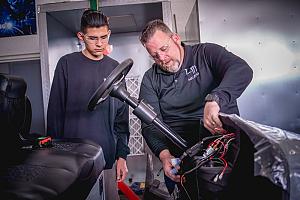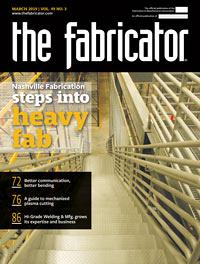President
- FMA
- The Fabricator
- FABTECH
- Canadian Metalworking
Categories
- Additive Manufacturing
- Aluminum Welding
- Arc Welding
- Assembly and Joining
- Automation and Robotics
- Bending and Forming
- Consumables
- Cutting and Weld Prep
- Electric Vehicles
- En Español
- Finishing
- Hydroforming
- Laser Cutting
- Laser Welding
- Machining
- Manufacturing Software
- Materials Handling
- Metals/Materials
- Oxyfuel Cutting
- Plasma Cutting
- Power Tools
- Punching and Other Holemaking
- Roll Forming
- Safety
- Sawing
- Shearing
- Shop Management
- Testing and Measuring
- Tube and Pipe Fabrication
- Tube and Pipe Production
- Waterjet Cutting
Industry Directory
Webcasts
Podcasts
FAB 40
Advertise
Subscribe
Account Login
Search
How a welder becomes a leader
How a shop floor quarterback becomes a business leader
- By Ken W. Mikesell
- March 2, 2019
- Article
- Shop Management
It was a cold morning, and the defrosters were just chasing the frost off the windshield as Bob Cramer drove to his breakfast meeting. The tips of his gloved fingers were still tingling as he gripped the cold steering wheel. It was chilly in the truck, but he recognized that the cold was not what was sending shivers through his body. It was fear. Fear of what a coming conversation could bring.
As he drove, he thought about where this had all started. The night before, at his son’s hockey game, he talked about his business with another hockey player’s dad, Phil Monroe. He had known Phil since last season when they met at a travel tournament in Colorado Springs. Since then their families often ate together after games so Phil and Bob regularly discussed their work. Phil knew about Bob’s family ownership of a custom sheet metal fabrication business, and Bob learned about Phil’s larger manufacturing business, but these past interactions had always been just small talk.
As he drove on, he considered the conversation from last night. Like their previous conversations, the business talk had started off with polite banter, but in a first for these dialogues, they had transitioned quickly into the strategic opportunities and challenges facing Bob’s business.
In the interaction, Bob let down his guard and had said things that he had never shared with anyone. He had even told him of his own insecurities about being able to lead his own company since his dad retired.
He had never shared his fears, and now they were out in the open.
Bob’s Story
He didn’t think he’d be following in his dad’s footsteps, but it happened all the same. Bob grew up in the fab shop. His father launched it decades ago after spending years as a welder and welding department supervisor at a large equipment manufacturer.
His dad thrived in the no-bull, just-do-it environment of his small job shop. He hated meetings and all things bureaucratic. In his dad’s mind, those who talked too much did too little. The welders, press brake techs, and cutting machine operators of the fab shop—these were the people who made a real difference.
Just like his dad, Bob was a natural and quickly developed a talent and a love for both fabrication and welding. However, as much as he flourished in that environment, he wasn’t sure job shop life was for him, so he left for engineering school. He still spent summers working at the shop, and in fact had such a good time doing so that he dreaded leaving for school in the fall. Therefore, two years into his degree, he decided that engineering school just wasn’t for him, and he started work full-time at the business.
Besides, his dad’s business was changing, and he was now needed to help with the growth. No longer a small job shop, the company now had several dozen employees and several million dollars in annual revenue. As the founder’s son, Bob became a shop-floor-operations quarterback of sorts, and he had hit his stride. He felt that he had found his life’s calling.
Several years ago Bob’s dad came into his office and sat down. It was now time—time for his dad to step away from the business, time to pass the baton. Bob grasped it firmly. He knew shop operations inside and out and got along with the shop floor folks, who in turn gave him support and respect.
As growth continued, all seemed right with the world—until it wasn’t. As order complexity increased, so did the headaches. Too often Bob would need to run to the floor to solve a problem. Why was this part bent out of tolerance? Why is the customer drawing incorrect? Why wasn’t this component ordered weeks ago?
Bob muscled through the problems, though, quite often by putting on a welding helmet himself just to get a job out the door on time. By sheer force of will, Bob and his business continued to build a good reputation in the market, so good, in fact, that a major equipment manufacturer recently came to him with a proposal—the largest blanket order the fabricator had ever seen.
It was a great opportunity that could take the fabricator to the next level. The move even made sense from a revenue diversification standpoint; the customer would open doors for entirely new markets.
But it would not be easy. Bob could buy equipment and hire people to take on the increased shop floor work load. Still, managing all of this additional volume and order-delivery complexity would be a challenge. How could he handle everything on the shop floor while dealing with increasingly sophisticated and demanding customers? He felt both overwhelmed and inadequate for the task. At that point, the true fear set in, buttressed by insecurity and doubt.
And what about his family? He still didn’t see them enough. He had finally delegated enough so he could attend his son’s hockey games, but that was a Band-Aid fix. Connected to his phone, he was continually answering calls and texts, firefighting from afar. Now he felt he was failing on both fronts, with his family and the business. Faced with that reality, how could he justify to anyone, and to himself most of all, that he could be successful in this new opportunity?
During a recent game, he put his phone down after averting another crisis, then plopped down despondently on the bleachers. Sensing his frustration, Phil, the manufacturing CEO, started a conversation with Bob about what was up. Bob looked at Phil for a moment, shook his head, but then opened up about what was on his mind.
“To be honest, Phil, as our shop gets bigger and bigger, my frustration gets the best of me.” Bob then explained the business opportunity that he was looking at, along with the issues his business faced every day, and then expressed concern about his ability to rise to the new challenge. After finishing, he paused for a few moments and then finally blurted out, “To be honest, I have this fear that on any given day I just won’t be able to hold the business together anymore. It’ll all just fall apart.”
Personal Growth
“Where had that confession come from? Phil probably thinks I am a nutcase,” Bob mused to himself the next morning. He wondered why Phil even wanted to continue the conversation. Instead, Phil had surprised Bob and suggested that they meet and carry on the discussion further over breakfast, to which he was now heading.
After he pulled up in front of the diner, Bob collected his thoughts as he walked through the front door. Although he was feeling anxious, he recognized that he had been avoiding this conversation with himself for some time. Maybe today he could face his fear. He had come to learn that Phil was a good listener, and perhaps he could give him insights he had never thought of.
As Bob slid into the booth opposite Phil, he jokingly said, “I am surprised you wanted to continue our talk after last night. It got pretty personal, and I thought that might scare you off.”
Phil quickly responded, “I really enjoyed the conversation. And I can relate. Like you, I was facing major challenges and opportunities with my business. I was being forced out of my comfort zone.”
Surprised at the response, Bob quietly mulled this over as the waitress came over with coffee.
Phil smiled, then started his story. “Almost two decades ago I graduated college as an engineer. Not long after I built a unique control system for large sorting machines that shipping companies use. I obtained seed money to start production and then started selling this product to several larger equipment manufacturers.
“I wore every hat in the company during those startup years. But after three years of growth and a dozen employees, we stopped growing. Without a change in direction, I determined that we could actually lose what we had gained.”
Bob nodded. “That sounds familiar. What did you do?”
“It took a while, but I finally realized that I was so busy designing and making products that I lost sight of our customers and where the market was going. It was like I was furiously shoveling coal into the boiler of a locomotive while not paying attention to where the train was headed, and it could be heading off of a cliff. I realized then that I needed to look down the track, drive the locomotive, and get someone else to feed the boiler.
“I replaced myself on the production floor so I could step up to the next level and be available to take on the new leadership roles needed for the business. I joined business organizations and sought out experts in production management systems and accounting to help create management tools to run the business. And I sought out help from an executive coach. Since then things have gotten easier. We’ve grown. We’re profitable. And I don’t spend my days putting out fires.”
“That sounds like you took all the right steps,” Bob quickly replied.
Phil shook his head. “I didn’t, unfortunately. In fact, I took a lot of wrong steps along the way. Every time the business grew to a new level, I faced a new set of challenges. I came to realize that with each step I took into a new leadership role, I needed to make sure someone else handled my previous duties. Sometimes I had to restructure the existing management team so I could step into the next level of leadership. And let me tell you, all that wasn’t easy. I made mistakes along the way that were downright painful.”
Bob acknowledged him, sat quietly for a few minutes, trying to absorb all that was said, then finally broke the silence. “So do you think what you went through applies to me?”
“Sure it does,” Phil responded quickly. “While the specifics of the businesses are different, the leadership challenges are identical. Last night you said you were facing opportunities for growth but were struggling with how you can capitalize on them. You stated that you felt inadequate and overwhelmed by the challenge. To be honest, I felt the same way.”
“So do I just do the same things you did?” Bob asked apprehensively.
Phil responded, “I can probably help you answer your own question. Tell me again about your business opportunity.”“As we talked about last night, a large equipment manufacturer approached us with a very profitable growth opportunity. But that added business will require us to increase personnel fourfold and also improve our technical, quality, and planning capabilities over the next two years as the business ramps up.
“It’ll be up to me to lead the effort,” Bob said with hesitation, “and that’s my fear, really. I’ll have to manage more people, more personalities, and improve our processes at the same time, so we can deliver. It seems like an overwhelming task.”
Tapping New Leaders
After a long pause, Phil said, “How would you go about managing all of this?”
“I guess I would have to assume that leadership responsibility. But I currently spend most of my time on the shop floor. I direct production. Heck, sometimes I even put on a welding helmet and help out, especially for our more complicated products.”
“You sound like I did years ago,” Phil said. “But you have an important choice to make for both yourself and your company. You can either continue to be the shop guy in a small operation or put up your welding helmet and lead your business through growth.”
Bob heaved a sigh. “Yeah, it’s time to hang up the welding helmet.”
They sat quietly for a long moment before Phil asked, “Now that you are accepting this new role, what are some first steps that you will have to take?”“It means I have to start having others take over the shop floor so I can step away and work on higher-level business issues. I’ll have to spend much less time on the shop floor, and someone else will be directing the work crews.” “That’s a great start,” Phil said. “You’ll find that you’ll spend a lot of time finding and working with future leaders to support each new level of opportunity. So where will you find these new leaders of yours?”Bob chuckled nervously. “Well, I could just replicate myself, right? But seriously, I would need people to take over what I’ve been doing on the shop floor, people who can also hold people accountable when it comes to quality and delivery. I’ll need to promote from within wherever I can, but where I can’t find those trusted and respected leaders, I’ll probably need to recruit new talent from the outside.”
Phil nodded and continued, “And you know what? Those leaders don’t have to be great welders or even your best sheet metal guru. In my experience, I found that while you can teach these leadership skills, not everyone is cut out to be a good supervisor or manager. But that’s OK. These technical experts still play important, critical roles. They should be recognized for their contribution with their own unique career path and compensation. That said, your shop leaders should be encouraged to value those technical experts and gain from their insights.
“Also know that you’ll need to develop new leaders—plural. It will be tough to replace all the roles you play with just one person.”
Bob followed up, “You’re right. It won’t be easy but I have some ideas already on where to start.”
“That’s good, but it’ll be a process, and it won’t happen overnight. When I started developing my replacements, I found that I had to go through multiple steps. When I started my business, I was the trailblazer. I made most decisions, people had to listen, and they had to toe the line to get things done. As my job grew with the business, I would take these same skills and develop my new role on this same model, creating a new path for the company and myself as only I could. I would often get insights and help from outside the company, but this advice still had to fit within the vision I had for the company.
“All those positions I previously held had to be backfilled to free me to grow into my new role. That is, as I moved on, others had to take over what I previously did. And as I backfilled each of my previous positions, I had to take on a different role with each replacement leader. I didn’t just hand off the baton and let the new guy run with it. If I did that, I’d just be setting up that new leader for failure.”
Phil continued, “These changes happened slowly, and when I first gave each leader new responsibilities, we would share them for a time just like a business partner. As they learned their new role, I continued to release control to them over those parts of the job they had learned well, but I stayed involved in those responsibilities they had not yet mastered. The full transition often took months. Their responsibilities grew quickly in some areas, slower in others, depending on how much they could take on successfully.
“Once they had assumed their new responsibilities fully, I would continue in a new role, one in which I was more of a coach to them. Once all their duties were assigned, I would only step in to help them learn new skills, make adjustments as needed, or just encourage them.
“I learned that a successful transition took some time—sometimes weeks, sometimes many months, depending on the person and situation. I learned that to be successful, I needed to ensure the transition occurred at a safe pace, to give them the time and support to succeed.
“Also, be sure you build a management structure that works for your customers,” Phil added. “For example, you might like a flat structure serving each market or customer like a mini-operation within your business, with few if any middle managers, just because it seems to be more efficient and less bureaucratic. Getting away from politics and bureaucracy is one reason your dad was successful in the first place, right?
“But the true judges of a good business structure will be the markets you serve. Will the structure meet their needs? If not, you need to think about building a management structure to meet those needs, and perhaps reach out to some management experts to help you. It’s not a cut-and-dried process.
“Most important of all, you need to be honest with yourself. Be brutally honest. You’ll need a plan based around your strengths and weaknesses. If you’re weak in one area, hire or promote a manager who’s strong in that area. If you’re truly honest with yourself all the time, the road ahead will be a lot easier.”
About Honesty
The morning sun had melted the frost from Bob’s windshield. Driving home, he kept thinking about what Phil said. Be brutally honest. Where was he weakest? Where did he shine?
He liked to fabricate and weld, but was it his strength? Not really. He could hang in there with most of his staff, but if a guy had a problem with a complex weldment, he knew he wasn’t the person people turned to for help. They turned to Joe, a longtime welder, skilled in stick, TIG, and MIG, with experience both on job sites and in the shop—and the irreverent sense of humor that came with that experience. Still, Joe’s attitude was in the right place, and he cared about producing a quality product, which was probably why Bob and Joe got along so well.
Joe was good with people and was able to get them to work together. Could Joe be a potential leader? Possibly, but several others could also fill that role. He had some good inside candidates.
Bob then thought about all the times shop operators turned to him about personnel problems, about who was producing and who wasn’t. It was an important part of his shop floor leadership role. He connected with people and could help them work through problems.
Problem was, he really couldn’t spend his time doing that anymore. Whoever took over shop floor supervision, whether it was Joe or someone else, would also have to take on the personnel management issues.
As Bob thought of his new role in the company, he considered the many things he would need to do: work more with current and future customers and markets, engage with business associations and the community, and, of course, build a pipeline for future talent. His focus couldn’t be inward anymore.
Of greatest importance, he would have to understand what his company would need to do to capitalize on this new business. All that he knew now was that what he was doing today would not cut it.
Bob had a lot of thinking to do. But at least now he felt he had direction, and that he was starting to ask the right questions.
Most critically, he now realized he had to move beyond his own comfort zone as shop floor quarterback and to grow personally as a leader. If he were unwilling to be the leader the business needed, he’d ultimately limit its growth.
Bob then recalled Phil’s last comments at the diner, as Bob insisted on picking up the check. “I have some names that I can forward to you as resources that can help you on this new path,” Phil said. “Of course, I am also willing to be a sounding board for you … for the price of a meal of course.”
Bob smiled. “It looks like I may be buying you breakfast every once and a while.”
Ken W. Mikesell is president of Lean Enterprise Solutions LLC, Arvada, Colo., 720-318-9191, www.bottomlinefix.com, a business and operational consulting and executive coaching firm. Mikesell brings almost three decades of metal fabrication, welding and machining experience to his practice. A certified welder himself, he still spends his spare time creating unique metal products for a variety of markets.
About the Author
subscribe now

The Fabricator is North America's leading magazine for the metal forming and fabricating industry. The magazine delivers the news, technical articles, and case histories that enable fabricators to do their jobs more efficiently. The Fabricator has served the industry since 1970.
start your free subscription- Stay connected from anywhere

Easily access valuable industry resources now with full access to the digital edition of The Fabricator.

Easily access valuable industry resources now with full access to the digital edition of The Welder.

Easily access valuable industry resources now with full access to the digital edition of The Tube and Pipe Journal.
- Podcasting
- Podcast:
- The Fabricator Podcast
- Published:
- 05/14/2024
- Running Time:
- 62:12
Cameron Adams of Laser Precision, a contract metal fabricator in the Chicago area, joins the podcast to talk...
- Trending Articles
What software automation means for custom fabrication

Why employee-owned companies make sense in manufacturing

Nucor’s weekly steel price announcement continues to rattle markets

Press brakes, panel benders, and flat blank calculations

Washington artist creates life-size elk sculptures

- Industry Events
Laser Welding Certificate Course
- May 7 - August 6, 2024
- Farmington Hills, IL
World-Class Roll Forming Workshop
- June 5 - 6, 2024
- Louisville, KY
Advanced Laser Application Workshop
- June 25 - 27, 2024
- Novi, MI
Precision Press Brake Certificate Course
- July 31 - August 1, 2024
- Elgin,



























